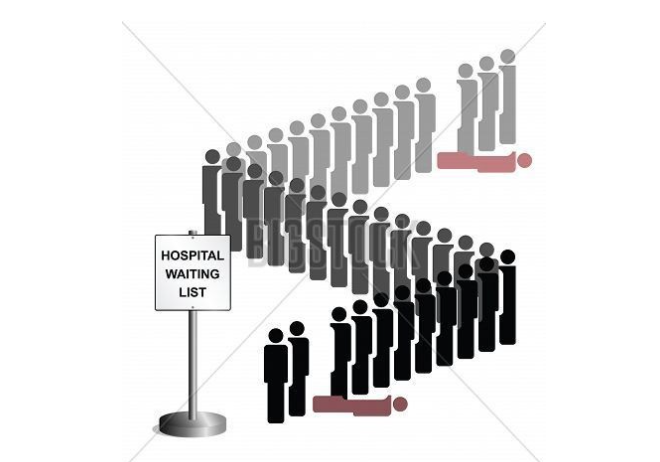All procedures underwent expressive reduction: screenings ~42% and high complexity surgeries ~28%, among others
This is an excerpt of paper below, with the title above, with a focus on the backlog crisis, preceded by an Executive Summary by the Editor of the Blog.
For a complete view of the Pandemic Response Assessment in Brazil, please, refer to the long version of the original publication, by the authors.
Brazil’s health system functionality amidst of the COVID-19 pandemic: An analysis of resilience
The Lancet Regional Health — Americas
Alessandro Bigoni,a,b,c, * Ana Maria Malik,a Renato Tasca,a Mariana Baleeiro Martins Carrera,a Laura Maria Cesar Schiesari,a Dante Dianezi Gambardella,a,d and Adriano Massuda a
Volume 10, June 2022, 100222
Executive Summary
by Joaquim Cardoso MSc.
Chief Editor of “The Health Strategy Blog”
March 7, 2022
What is the problem? What is the size of the problem?
The acute shock caused by the COVID-19 resulted in a sharp drop in non-covid healthcare procedures in the SUS.
- The study found that the acute shock brought to the Brazilian public health system by the COVID-19 epidemic resulted in an acute drop in non-covid healthcare procedures in the country despite the increase in human, physical, and financial resources.
All procedures underwent expressive reduction: screenings ~42% and high complexity surgeries ~28%, among others
All procedures underwent expressive reduction (in 2020)
- Screenings (−42·6%);
- Diagnostic procedures (−28·9%);
- Physician appointments (−42·5%);
- Low and medium complexity surgeries (−59·7%);
- High complexity surgeries (−27·9%);
- Transplants (−44·7%);
- Treatments and clinical procedures due to injuries of external causes (−19·1%);
- Irrepressible procedures (−8·5%);
- and Childbirths (−12·6%).
Surgeries of low and medium complexity, transplants, and screening procedures were the most affected, with most states experiencing a reduction of more than 50% throughout 2020·
The most significant drop in procedures happened in the first quarter of the pandemic, followed by progressive increase; most regions had not yet recovered by the end of 2020.

What are the causes of the problem?
- The impact of COVID-19 on health systems across the world was seen mainly as a problem to be dealt with in the present, with little planning regarding its future impacts.
- Results show that the distribution of resources did not prioritize the most vulnerable states, which were the most affected by the drop in procedures.
- Thus, the increase in financing, workforce, and infrastructure was not allocated to prevent the decrease in diagnostic and screening procedures is particularly alarming, as well as the drop in treatments that require complex surgeries (i.e., oncology, neurology and cardiac surgery).
- Social distancing and the recommendation that individuals did not leave their homes unless strictly necessary, together with hospitals postponing procedures to focus on COVID-19 patients, meant a reduction of elective surgeries.
- This fact did not occur only in Brazil. Countries with more robust health systems, such as Italy 42 Spain 43 and different regions of Asia, also reported an impact in elective procedures.44 ,45
- Although part of the drop in procedures can be attributed to changes in the population’s behavior, we argue that the lack of plans of action in place, such as screening campaigns adapted to the COVID-19 reality and strategies incentivizing vulnerable populations to go to hospitals in the case of any non-COVID-19 related symptoms, led to the reduction of timely diagnoses and procedures.
What will be the future consequences?
- The drop in diagnostic and screening procedures is particularly concerning.
- A proportion of those who avoided going to hospitals or clinical appointments or had their visits cancelled by physicians due to an overcrowded hospital or fear of infection will lead to poorer outcomes in the near to mid future.36
- The sudden drop in the reporting of new cancer cases is worrisome.38
- There is an indication that the pandemic already impacted patients potentially needing surgeries by delaying diagnostic and treatment.39
- The impact in oral and oropharyngeal biopsies 40 and hospitalizations 41 have been documented in Brazil, but more studies are required to explore the implications in other cancer types.
- The same scenario seen in diagnostic and screening procedures is also found in surgeries, especially low and medium complexity ones.
What are the recommendations (by the editor of the blog)
- In face of this huge backlog (based in statistics for 2020 only), it´s necessary to formulate strategies and allocate resources to solve “The Backlog Crisis” in Brazil.
ORIGINAL PUBLICATION (excerpt)

SUMMARY
Background
As of December 31, 2020, Brazil had the second-highest burden of COVID-19 worldwide. Given the absence of federal government coordination, it was up to the local governments to maintain healthcare provision for non-COVID health issues. In this descriptive study, we aimed to discuss the SUS functionality and resilience, describing the impact of the pandemic on non-COVID health services delivery while considering the regional inequalities of the allocation of financing health system, health infrastructure and health workforce.
Methods
We used input-output framework based on the World Health Organization (WHO) Health System Building Blocks to estimate health system functionality and resilience. An ecological assessment was designed to calculated mean relative changes to compare the first year of the pandemic in Brazil with the previous one. All data used in this study were anonymized and made available by the Brazilian Ministry of Health. Input indicators were categorized in health system financing (federal funding received as well as expenditure of both state and city governments), health system’s infrastructure (hospital beds) and health workforce (healthcare workers positions). Output indicators were categorized into nine different groups of service delivery procedures. To explore the relationship between the variation in procedures with socioeconomic conditions, we used the Socioeconomic Vulnerability Index (SVI).
Findings
State governments had a 38·6% increase in federal transfers, while municipal governments had a 33·9% increase. The increase of ICU beds reached its peak in the third quarter of 2020, averaging 72·1% by the end of the year. The country also saw an increase in jobs for registered nurses (13·6%), nurse assistants (8·5%), physiotherapists (7·9%), and medical doctors (4·9%). All procedures underwent expressive reduction: Screenings (−42·6%); Diagnostic procedures (−28·9%); Physician appointments (−42·5%); Low and medium complexity surgeries (−59·7%); High complexity surgeries (−27·9%); Transplants (−44·7%); Treatments and clinical procedures due to injuries of external causes (−19·1%); Irrepressible procedures (−8·5%); and Childbirths (−12·6%). The most significant drop in procedures happened in the first quarter of the pandemic, followed by progressive increase; most regions had not yet recovered by the end of 2020. State-level changes in numbers of procedures point towards a negative trend with SVI.
Interpretation
The Brazilian Government did not consider that socioeconomically vulnerable states were at a higher risk of being impacted by the overburden of the health system caused by the COVID-19, which resulted in poorer health system functionality for those vulnerable states. The lack of proper planning to improve health system resilience resulted in the decrease of a quarter of the amount of healthcare procedures increasing the already existing health disparities in the country.
Funding
MCTIC/CNPQ/FNDCT/MS/SCTIE/DECIT No 07/2020.
EXCERPT (of the long version)
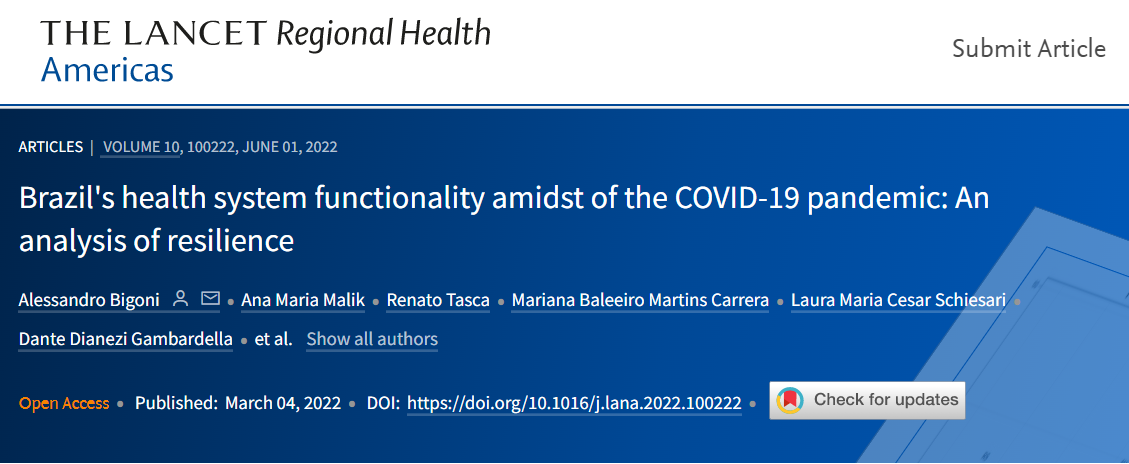
Brazil’s health system functionality amidst of the COVID-19 pandemic: An analysis of resilience
The Lancet Regional Health — Americas
Alessandro Bigoni,a,b,c, * Ana Maria Malik,a Renato Tasca,a Mariana Baleeiro Martins Carrera,a Laura Maria Cesar Schiesari,a Dante Dianezi Gambardella,a,d and Adriano Massuda a
Volume 10, June 2022, 100222
Originally published at https://www.sciencedirect.com.
Introduction
Registering more than 36·55 cases and 0·93 deaths per thousand inhabitants as of December 31, 2020, Brazil had the second-highest burden of coronavirus disease 2019 (COVID-19) worldwide.
In 2021, as of October 1st, the country recorded more 402,220 deaths caused by COVID-19, the highest number in the world.
METHODS (excerpt)
We used an input-output framework based on the World Health Organization (WHO) Health System Building Blocks elements to estimate health system functionality and resilience.14
We designed an ecological assessment that compares the quarters of the first year of the pandemic in Brazil with the respective quarters of the previous year. This decision was taken to account for seasonal variations within the service provision data.
We opted not to use other approaches such as the mean values of previous years because we believe that the continuous decline of healthcare production since the economic crises of 2016 would inflate the estimates, not reflecting the scenario that SUS was facing immediately before the pandemic.
Throughout the text, we often refer to 2019 as the “pre-pandemic” period and 2020 as the “pandemic” period. All data presented in this study are anonymized and made available by the Brazilian MoH through its open data repository (https://datasus.saude.gov.br/) and were downloaded in June 2021.
Input-indicators
Health financing: We gathered information on governmental fund transfers from the Information System on Public Health Budgets (SIOPS). The SIOPS dataset contains all Federal funds transfers to state and municipal governments and their expenditures.
Health infrastructure: We used the Brazilian National Registry of Health Facilities (CNES) to obtain data on hospital beds and healthcare workers. We divided hospital beds into two groups, Intensive Care Unit (ICU) hospital beds and other hospital beds.
Health workforce: We extracted the mean values of medical doctors, registered nurses, nursing assistants, and physiotherapists for the period. Healthcare workers were grouped using the Brazilian Classification of Occupations (CBO) identification numbers. The CNES database enables the identification of workers through their National Health Registry number, which allows to estimate the total of individuals employed and on contract, thus permitting to estimate the average number of job positions occupied by individuals. We did not filter the workers data by their role in the establishment.
Output-indicators
Health service delivery: Data on procedures are available monthly through the Outpatient Information System (SIA) and the Hospital Information System (SIH). The data used here contain the most up to date information as of June 2021, in order to avoid the usual 16-week delay in reporting. Once registered on the Brazilian health system, every procedure has an identification number. The health facility that performs the procedure needs to register details about it and provide information on the patients and their health conditions, using standardized forms, to receive payment for the procedure performed. The registration quality of some groups of procedures may vary according to financial incentives and convenience.
We created nine groups of procedures: diagnostic (diagnostical procedures such as radiology, magnetic resonance, or tomography), screening (cytopathological investigations, ultrasonography, endoscopies, and radiological interventions), irrepressible (oncological and nephrological treatments), physician appointments (all appointments with physicians and clinical treatments), low and medium complexity surgeries (all surgeries that did not require hospital admissions), high complexity surgeries (surgeries that required hospital admissions), transplants, external causes (treatments of injuries and accidents), and childbirths. A more thorough explanation of how the groups were created can be found on Supplementary Table 1. We excluded all COVID-related procedures from our analysis in order to focus on the impact on other conditions. We did this by explicitly excluding COVID-19 procedures (Supplementary Table 1) and excluding procedures that listed the ICD10 codes U071, U072, B342 or U04 as the primary diagnosis.
The mentioned datasets contain standardized geolocation codes for all the observations.
The total number of procedures was obtained by calculating the sum of procedures conducted during each period; we used averages to assess the numbers of hospital beds and health workers.
We aggregated procedures according to the municipality where the patient lived; when this information was not available, we used the information regarding the city where the procedure was performed.
Lastly, to create the figures, we aggregated all variables at the Regional level. We aggregated all variables at the state and country levels to create the tables.
Municipal population estimates by municipality and year provided by the Brazilian Institute of Geography and Statistics (IBGE) were aggregated at the Health Region level.
Monthly population estimates were calculated using linear interpolation, and rates per 10·000 inhabitants were calculated for all indicators and Health Regions.
We used the relative change in percentages to estimate the increase or decrease of our indicators. All estimates and figures were generated using Stata v15·1.
RESULTS (excerpt)
Health system delivery
In 2020, Screenings (−42·6%); Diagnostic procedures (28·9%); Physician appointments (−42·5%); Low and medium complexity surgeries (59·7%); High complexity surgeries (−27·9%); Transplants (−44·7%); Treatments and clinical procedures due to injuries of external cause (−19·1%); Irrepressible procedures (-8·5%); Childbirths (−12·6%); and all other procedures (−15·5%) suffered a gradual reduction in all quarters.
Collectively, the country saw a quarter reduction in its healthcare production (Table 4).
A larger drop is seen in screenings, appointments with physicians, high complexity surgeries, transplants, low and medium complexity surgeries, and diagnostic procedures.
Table 4. Rates of procedures (per 100 hab.) in 2020 and its mean relative change (%) in relation to 2019.
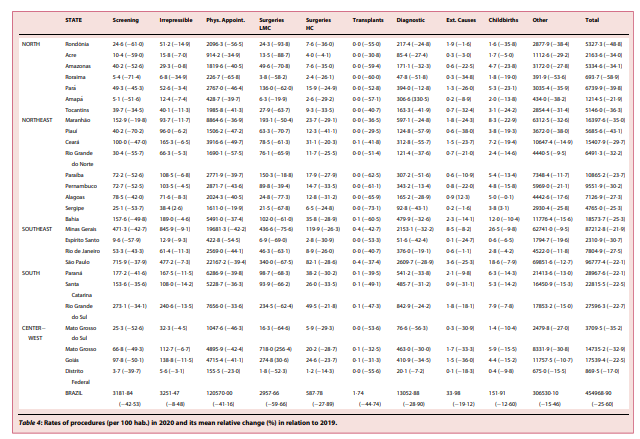
A larger drop is seen in screenings, appointments with physicians, high complexity surgeries, transplants, low and medium complexity surgeries, and diagnostic procedures.
Surgeries of low and medium complexity, transplants, and screening procedures were the most affected, with most states experiencing a reduction of more than 50% throughout 2020·
Treatments and clinical procedures due to external cause injuries experienced a slow but steady decline in all regions.
The same pattern is seen in childbirths, and irrepressible procedures were also affected, especially in the Northern region.
The prevalent pattern throughout the year was one of an inverted “J,” showing a strong contraction during the second quarter with a gradual recovery in the third and fourth quarters, but insufficient to go back to the pre-pandemic production.
Low and medium-complexity surgeries were the exception, with almost no recovery achieved during the period (Figure 4).
Surgeries of low and medium complexity, transplants, and screening procedures were the most affected, with most states experiencing a reduction of more than 50% throughout 2020·
Figure 4. Relative change distribution of procedures rates in health regions by procedure group, major region, and quarter. *Significant at the 5% level.
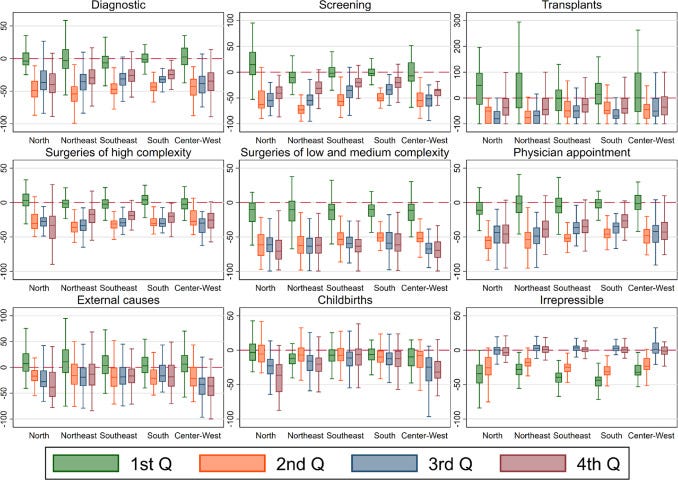
Scatter plots of state-level changes in numbers of procedures point towards a negative trend with SVI, meaning that more vulnerable states experienced a more considerable drop in screenings, physician appointments, surgeries of high complexity, transplants, childbirths, and diagnostic procedures. T
The impact in procedures and treatments for external causes and low and medium complexity surgeries doesn’t appear to correlate with SVI.
Irrepressible procedures were the only ones to indicate a positive trend in the relationship between the relative change of procedures and the SVI.
The most significant drop in procedures happened in the first quarter of the pandemic (March-May 2020), followed by a progressive stabilization.
However, most regions had not yet recovered by the end of 2020 (Figures 5 and 6).
Figure 5. Correlations between Socioeconomic Vulnerability Index and relative change of healthcare production by procedure group and UF.
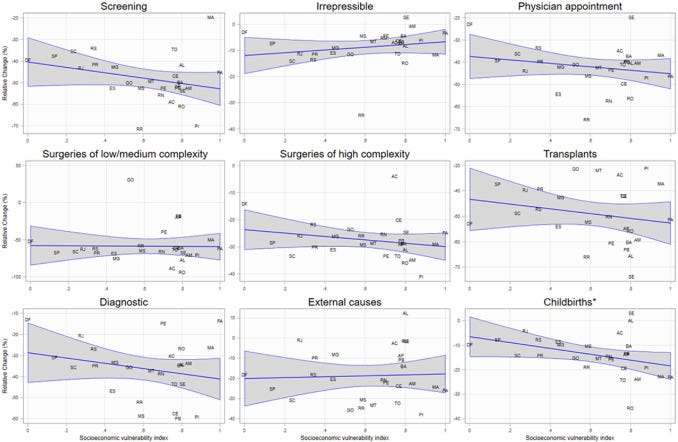
*Significant at the 5% level.
Figure 6. Relative change distribution of procedures rates in health regions by major region and quarter and correlation between Socioeconomic Vulnerability Index and relative change of healthcare production by UF.
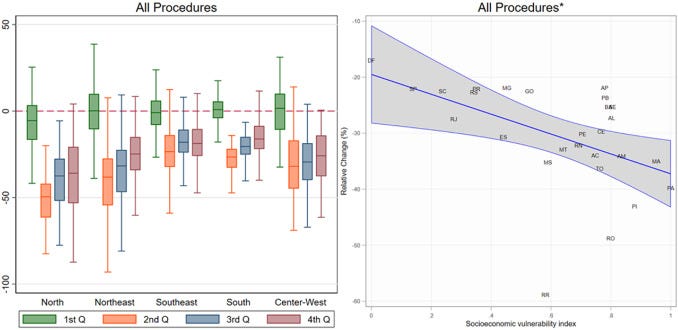
*Significant at the 5% level.
Discussion (excerpt)
Health systems worldwide are experiencing profound and prolonged shocks from the COVID-19 pandemic, raising attention to health system resilience.
The acute shock caused by the COVID-19 resulted in a sharp drop in non-covid healthcare procedures in the SUS.
Results show that the distribution of resources did not prioritize the most vulnerable states, which were the most affected by the drop in procedures.
Thus, the increase in financing, workforce, and infrastructure was not allocated to prevent the decrease in diagnostic and screening procedures is particularly alarming, as well as the drop in treatments that require complex surgeries (i.e., oncology, neurology and cardiac surgery).
… the increase in financing, workforce, and infrastructure was not allocated to prevent the decrease in diagnostic and screening procedures is particularly alarming, as well as the drop in treatments that require complex surgeries (i.e., oncology, neurology and cardiac surgery).
A health system’s ability to maintain improvements caused by the response to shock is an essential element of resilience.28
The significant increase of healthcare job positions but not in the number of healthcare workers probably imposed substantial influence on the number of front-line workers reporting burnout and experiencing a decline in mental health and overall wellbeing.32,33
Medical doctors did not experience a similar change in the rate per 1000 inhabitants or contracts per worker ratio. This is likely because doctors already had the highest proportion of job contracts per doctor. Thus, medical doctors are already in short supply in a health system that heavily relies on their work.
Our graph in Figure 5 only shows trends starting in 2019, but Brazilian healthcare workers have been subjected — and sometimes succumbed to — overworking and burnout for quite some time.34
The dissolution of legislative measures that increased the legal limit of hours healthcare workers could work per week likely aggravated the already grim reality these workers were facing.35
It is necessary to further inquiry into the dynamics that caused the loss of job positions for medical doctors and physiotherapists in Rio de Janeiro e Piauí.
The impact of COVID-19 on health systems across the world was seen mainly as a problem to be dealt with in the present, with little planning regarding its future impacts.
However, the near collapse of health systems and the fear caused by a scientific denialist government in Brazil affected the pandemic response and set a pessimistic perspective for the future.
Procedures to care for non-covid related causes had an intense drop in 2020.
Procedures to care for non-covid related causes had an intense drop in 2020.
A proportion of those who avoided going to hospitals or clinical appointments or had their visits cancelled by physicians due to an overcrowded hospital or fear of infection will lead to poorer outcomes in the near to mid future.36
Those individuals — especially those with chronic conditions — are referred to as “invisible patients,” The consequence is an incoming “third wave”, as it was called in 2021.37
A proportion of those who avoided going to hospitals or clinical appointments or had their visits cancelled by physicians due to an overcrowded hospital or fear of infection will lead to poorer outcomes in the near to mid future.
The drop in diagnostic and screening procedures is particularly concerning.
The sudden drop in the reporting of new cancer cases is worrisome.38
There is an indication that the pandemic already impacted patients potentially needing surgeries by delaying diagnostic and treatment.39
The impact in oral and oropharyngeal biopsies 40 and hospitalizations 41 have been documented in Brazil, but more studies are required to explore the implications in other cancer types.
The drop in diagnostic and screening procedures is particularly concerning.
The sudden drop in the reporting of new cancer cases is worrisome.
There is an indication that the pandemic already impacted patients potentially needing surgeries by delaying diagnostic and treatment
The same scenario seen in diagnostic and screening procedures is also found in surgeries, especially low and medium complexity ones.
The same scenario seen in diagnostic and screening procedures is also found in surgeries, especially low and medium complexity ones.
Social distancing and the recommendation that individuals did not leave their homes unless strictly necessary, together with hospitals postponing procedures to focus on COVID-19 patients, meant a reduction of elective surgeries.
This fact did not occur only in Brazil. Countries with more robust health systems, such as Italy42 Spain43 and different regions of Asia, also reported an impact in elective procedures.44,45
Although part of the drop in procedures can be attributed to changes in the population’s behavior, we argue that the lack of plans of action in place, such as screening campaigns adapted to the COVID-19 reality and strategies incentivizing vulnerable populations to go to hospitals in the case of any non-COVID-19 related symptoms, led to the reduction of timely diagnoses and procedures.
Although part of the drop in procedures can be attributed to changes in the population’s behavior, we argue that the lack of plans of action in place, …led to the reduction of timely diagnoses and procedures.
The WHO recommends social isolation to slow the rate of infection. Some Brazilian governors and mayors adopted the measure despite the federal government’s reluctance. These measures also impacted injuries by external causes, reducing the number of hospitalizations that would have happened under normal circumstances.
This study shows that all regions experienced a drop in medical procedures related to external causes in the first quarter of the pandemic, likely due to a decline in traffic and road accidents.46,47
The impact on deaths by external causes is also likely one of the main factors of the drop in organ transplantations.48
The drop in childbirths shown in this study is yet unexplored in Brazil. Our data are only related to childbirths performed at the public health system, but it is unlikely that women moved to the private sector in large quantities.
The more likely explanation is that the economic impact of the COVID-19 pandemic and the fear of infection made women decide to postpone a possible pregnancy. A similar scenario was seen during the Zika Virus outbreak of 2016 in Brazil.49 There is no substantial evidence that this trend, which appears to have happened worldwide, should be attributed to sociocultural factors alone.50,51 The possibility that this drop should be attributed to physiopathological effects of the SARS-CoV-2 is being investigated; however, more studies are needed to explore causal links.52,53
Irrepressible procedures show a different pattern than the other groups. The decline in the number of procedures seems to have started before the pandemic arrived in the country, and then it slowly returned to its typical values. This is not an effect of the pandemic but rather the result of a change in the registry norms for some oncological treatment procedures, implemented in May 2019.54 The robust stabilization seen in the last two quarters of 2020 suggests that health facilities were able to maintain their levels of oncological and nephrological treatments.
Despite the country’s health services inequalities, the evidence exposes a critical similarity of the country’s response: Brazil’s effort to deal with the pandemic was centered around the hospital’s human and physical resources instead of preventive actions on primary care.
Brazil’s effort to deal with the pandemic was centered around the hospital’s human and physical resources instead of preventive actions on primary care.
Although further investigation is needed to infer causation from this policy decision, it is possible to argue that SUS and its decentralized structure rapidly increase health system capacity when increased financial support is given.
This aspect highlights a positive element of SUS resilience. Despite being worsened by the lack of federal support to manage the crises, health system functionality remains due to municipal government’s role in service delivery, ensuring large-scale public health interventions in a continental and profoundly unequal country. As a result, more than 143 million Brazilians (70% of population) were fully vaccinated for COVID-19 as of January 2022, 55 despite Bolsonaro’s government rhetoric against vaccination.
References & additional information
See the original publication
About the authors & affiliations
Alessandro Bigoni ,a,b,c, *
Ana Maria Malik ,a
Renato Tasca ,a
Mariana Baleeiro Martins Carrera ,a
Laura Maria Cesar Schiesari ,a
Dante Dianezi Gambardella ,a,d and
Adriano Massuda a
a São Paulo School of Business Administration, Fundação Getulio Vargas, Avenida Dr Arnaldo 715, São Paulo, SP CEP-01246–904, Brazil
b School of Public Health — University of São Paulo, São Paulo, SP, Brazil
c Harvard T.H. Chan School of Public Health, Boston, MA, USA
d Real e Benemérita Associação Portuguesa de Beneficência, São Paulo, SP, Brazil




